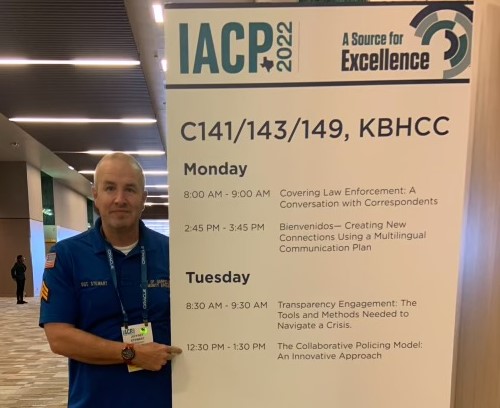Police departments might seem unlikely partners in an age-friendly coalition.
Not so in the City of Garfield, where Sgt. Jeffrey Stewart, commander of the Garfield Police Department’s Community Affairs Division, has served as the project coordinator for Generations for Garfield since 2018.
Stewart was part of the broad coalition of municipal and civic leaders who helped found Generations for Garfield, an age-friendly community initiative that has led to a host of new community-bonding initiatives, including the opening of a Community Engagement Center
From its early days, Generations of Garfield has always embraced what Stewart and other leaders call “unlikely partnerships.”
In addition to Stewart, the initiative has largely been shaped by Garfield’s now-retired public health nurse Darleen Reveille and by Shannon Lyons, a research scientist at New York University School of Medicine and a senior fellow in the NYU’s Aging Incubator program.
The three have enlisted a broad coalition of municipal and civic leaders in their efforts to identify and address the needs of older Garfield residents. In recent years, they have expanded their mission to educating local, regional, national and international audiences about the benefit of combining collaborative policing principles with age-friendly practices.
Some of those audiences might seem just as unlikely as their age-friendly partnership, including a presentation they made in October 2022 to the International Association of Chiefs of Police.
The event was one of the largest and farthest-reaching platforms for one of Generations for Garfield’s core messages, which is that developing a collaborative policing model goes hand-in-hand with building an age-friendly community, and vice versa.
“As our population gets older, it’s important for law enforcement agencies to better serve older adults,” Stewart said. “An age-friendly approach to policing means understanding the needs and vulnerabilities of older community members, including mental health challenges, social isolation, and food insecurity, to name a few.”
Stewart has educated hundreds of officers in Garfield and elsewhereabout the challenges older populations face and how they can work collaboratively with other city departments and civic organizations to address them.
“Officers need more training and awareness on how to interact effectively and compassionately with seniors, recognize signs of elder abuse, and provide clear, accessible communication for those with hearing or vision impairments.” Stewart said. “To better serve these individuals, officers need to dig deeper to understand their circumstances. This is why age-friendliness and awareness are so important—police can better support and build trust within a significant portion of the community by adopting these principles.”
Stewart credits his work with the age-friendly coalition as broadening his own understanding of how to serve and protect older community members.
“Before getting involved in age-friendly work, I never realized the amount of food insecurity, the extent of social isolation, the lack of comfort with technology, and the feeling that many older residents have of not belonging to the community,” Stewart said.
Stewart is now passionate about sharing his expanded perspective with others in uniform. He has secured grants that have allowed him to lead training sessions on age-friendly-informed collaborative policing strategies across New Jersey and in states as far away as Florida, Texas and California. Most recently, he was awarded a research fellowship with New Blue, a national organization that funds projects seeking to promote forward-thinking approaches to policing.
Part of the message that he and his colleagues at Generations for Garfield want to impart to other age-friendly leaders is that a robust partnership with the police department is crucial to helping identify the policy and systems changes an individual community needs to create a more age-friendly environment for all.
One example that Stewart and Lyons cite in Garfield was the city’s decision to contract with a social services liaison, an individual that police officers in particular can connect with if they encounter residents who require assistance more so than police intervention.
The creation of this new social services position in Garfield has helped connect struggling older residents to food assistance and social service resources – and helped officers deal with crisis situations like hoarding and mental illness or more routine ones like an older resident needing a ride to a medical appointment.
Leaders of Generations for Garfield are taking a lead role in trying to expand the number of communities participating in Age-Friendly North Jersey through a new grant-funded project to assist five Bergen County towns in forming an age-friendly community initiative.
In addition to engaging leaders of the health departments serving Carlstadt, Elmwood Park, Fairview, Lodi and Wallington, Stewart has also connected with policing representatives in those towns to share his police-informed perspective on age-friendly work.
“We’re trying to demonstrate the value of our model of coalition-building, and the importance of incorporating policing and police representatives into their age-friendly community goals,” Lyons said.
In the hope of encouraging more police participation in age-friendly work, Stewart and Lyons will be leading a presentation on police partnerships at a virtual Age-Friendly North Jersey alliance meeting at 2 pm on Sept. 19. To join that event, register here.

